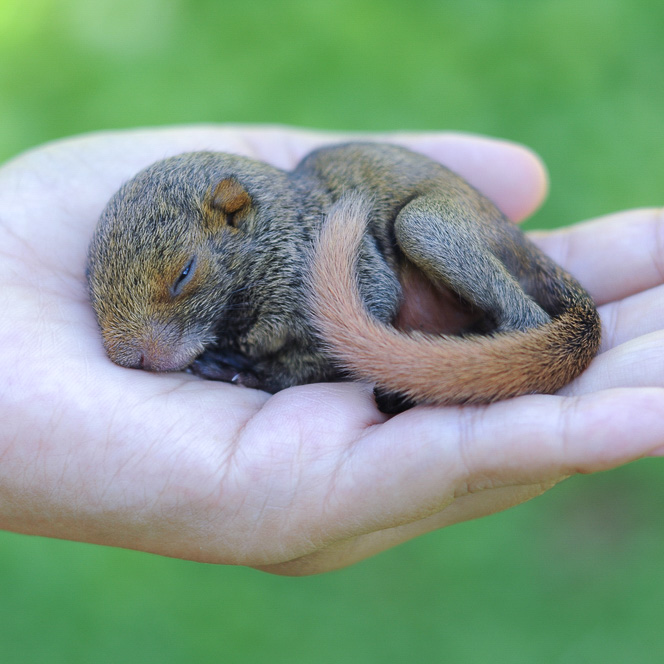
Caring for a Baby Squirrel: A Comprehensive Guide
Introduction
Baby squirrels are undeniably adorable creatures, but they are also incredibly vulnerable. If you come across an orphaned or injured baby squirrel, it is essential to provide proper care to ensure its survival and well-being. This comprehensive guide will provide you with all the necessary information on how to care for a baby squirrel, from feeding and housing to socialization and release.
Assessing the Situation
Before attempting to care for a baby squirrel, it is crucial to assess the situation and determine if intervention is necessary. Here are some key factors to consider:
- Age: Baby squirrels typically open their eyes around 4-5 weeks of age. If the squirrel’s eyes are still closed, it is likely too young to be separated from its mother.
- Condition: Examine the squirrel for any injuries or signs of illness. If the squirrel is injured or appears weak or lethargic, it requires immediate veterinary attention.
- Location: If the squirrel is in a dangerous location, such as on the ground or near a road, it should be moved to a safer area. However, do not move the squirrel far from its original location, as its mother may be searching for it.
Feeding
Baby squirrels require a specialized diet to meet their nutritional needs. The most suitable food for them is a commercial formula specifically designed for baby squirrels. These formulas are available at pet stores or veterinary clinics.
- Frequency: Feed the baby squirrel every 2-3 hours during the day and every 4-5 hours at night. As the squirrel grows older, the feeding frequency can be gradually reduced.
- Amount: The amount of formula to feed depends on the squirrel’s age and weight. Follow the instructions on the formula packaging or consult with a veterinarian for specific recommendations.
- Method: Use a syringe or dropper to gently feed the squirrel. Do not force the formula into the squirrel’s mouth, as this can cause aspiration.
Housing
Baby squirrels require a warm and secure environment to thrive. Here are some guidelines for creating a suitable housing setup:
- Enclosure: Use a small box or cage lined with soft material, such as fleece or towels. The enclosure should be large enough for the squirrel to move around comfortably but not so large that it gets lost.
- Temperature: Baby squirrels are unable to regulate their body temperature, so it is essential to keep them warm. Place a heating pad or hot water bottle wrapped in a towel in one corner of the enclosure.
- Humidity: Squirrels require a humid environment to prevent dehydration. Place a small dish of water in the enclosure or use a humidifier to increase the humidity level.
Hygiene
Maintaining proper hygiene is crucial for the health of a baby squirrel. Here are some tips:
- Bathing: Baby squirrels do not need to be bathed regularly. However, if the squirrel gets dirty or soiled, you can gently wipe it down with a warm, damp cloth.
- Cleaning the enclosure: Clean the squirrel’s enclosure daily to remove any waste or debris. Use a mild disinfectant solution to clean the enclosure and all surfaces that the squirrel comes into contact with.
- Grooming: As the squirrel grows older, it will start to groom itself. However, you can help by gently brushing its fur to remove any tangles or debris.
Socialization
Baby squirrels are social animals and require interaction with other squirrels or humans to develop properly. Here are some ways to socialize a baby squirrel:
- Handling: Handle the squirrel gently and regularly to get it used to human contact. Avoid excessive handling, as this can stress the squirrel.
- Playtime: Provide the squirrel with toys and activities to encourage play and exploration. This will help develop its motor skills and cognitive abilities.
- Interaction: Talk to the squirrel in a soft and soothing voice. This will help it get used to human voices and sounds.
Release
The ultimate goal of caring for a baby squirrel is to release it back into the wild. Here are some guidelines for a successful release:
- Age: Squirrels are typically ready for release around 12-16 weeks of age. They should be able to eat solid food, climb trees, and interact with other squirrels.
- Location: Release the squirrel in a safe and suitable habitat, such as a park or wooded area. Choose a location where there is an established squirrel population.
- Soft release: Consider a soft release approach, where the squirrel is gradually introduced to the wild over a period of several days. This allows the squirrel to adapt to its new environment and find food sources.
Additional Tips
- Veterinary care: Regularly take the baby squirrel to a veterinarian for checkups and vaccinations.
- Patience: Caring for a baby squirrel requires patience and dedication. It may take several weeks or months before the squirrel is ready for release.
- Contact a wildlife rehabilitator: If you are unable to care for the baby squirrel yourself, contact a licensed wildlife rehabilitator for assistance.
Conclusion
Caring for a baby squirrel is a rewarding but challenging experience. By following the guidelines outlined in this comprehensive guide, you can provide the necessary care and support to ensure the squirrel’s survival and well-being. Remember to prioritize the squirrel’s needs, seek professional assistance when necessary, and ultimately aim to release the squirrel back into its natural habitat.
